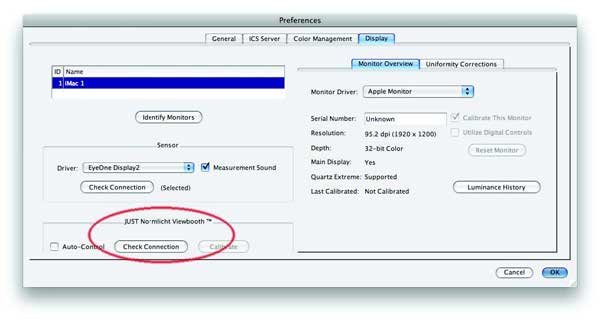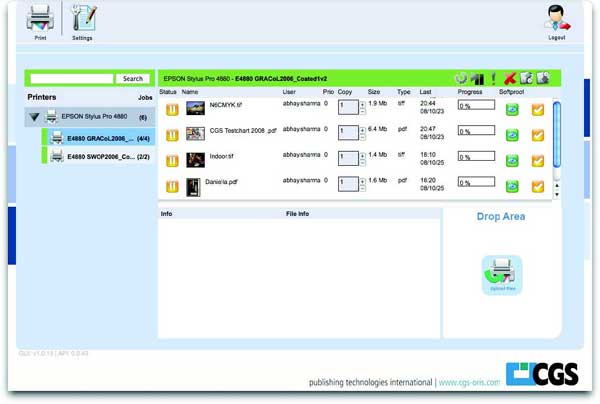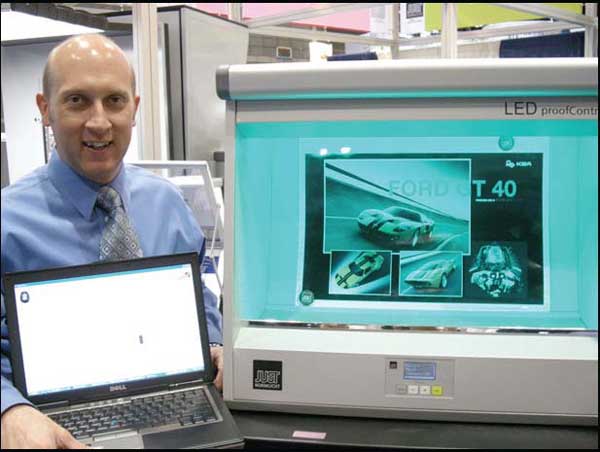|
By Abhay Sharma At Graph Expo in Chicago, Oct 26-29, 2008 a number of soft proofing technology developments were unveiled, as suppliers continue to improve their products in response to user needs and experiences. ICS Remote Director showed spectral blending for spot color support, DALiM DiALOGUE launched a new “ES” version, CGS Oris showed a web interface for hard and soft proofing and JUST Normlicht launched a revolutionary USB-controlled LED light booth. This article reviews the issues surrounding soft proofing and analyzes the importance of the new developments the suppliers are bringing to market. Monitor Soft Proofing For color accurate monitor soft proofing we need a good quality, stable monitor. Most solutions in the graphic arts are currently using Eizo and Apple displays, however other makes seen at Graph Expo include NEC displays, the HP DreamColor and Quato monitors. Uniformity from one side of the screen to the other remains an issue for all brands. Procedures were shown at Graph Expo, by Remote Director, to take measurements from the screen and then use software corrections to improve uniformity. It is likely that this procedure will increase the monitor brands that can be used for soft proofing. The color gamut of the monitor needs to encompass most commonly used print gamuts. Images are displayed in a manner that simulates a press condition, thus the screen needs to accurately display at least, all press colors. It is important that a soft proofing product is able to apply a gamut stain in areas that are out of the gamut of the display, so that the user knows not to place too much importance on a color that cannot be displayed accurately. Not all jobs will have out of gamut colors, and only very colorful jobs may stretch the capabilities of the display. 
Figure: A colorful hot air balloon image (left) cannot be satisfactorily reproduced on a conventional sRGB monitor (centre) as yellows, greens and blues of the image are out of gamut of the monitor. The Eizo display has a larger gamut (right) and can therefore accurately display nearly all of the colors in the balloon image. (Click to Enlarge) Calibration is another key aspect of soft proofing. Any system should constantly display the status of the user and also interrogate remote collaborators and display the status of their monitor; all parties in the collaboration session should be able to see the status of other participants. Finally it is beneficial if the system is SWOP certified and the user can print a color-managed hard copy version of the approved proof. ICS Remote Director Remote Director is a mature product, ICS were showing their new release Remote Director v3.6.1 in Chicago. The new version introduces a feature for spot color mixing based on spectral measurements of a printed color sample. The software uses measurement of, for example, a 100% PMS 485 patch and the paper white to predict on the screen, the appearance of various tints. Built into the software is the ability to deal with different paper stocks, thus it is possible to load a file that represents Sappi Opus Gloss or Sappi McCoy Gloss, etc. Remote Director is able to communicate via USB, with the JUST Normlicht Color Communicator2 light booth to ensure that the luminance of the screen and the light booth match; this condition is needed when trying to achieve a screen to print match, and it improves consistency and repeatability when the program does this automatically rather than leaving it in the hands of a human operator. 
Figure: ICS Remote Director v3.6.1 now includes the ability to communicate directly with the JUST Normlicht light booth to ensure that the luminance level on screen matches the luminance level set of the light booth.(Click to Enlarge) DALiM DiALOGUE “ES” 
Figure: DALiM DiALOGUE ES is a new, job-oriented version of the traditional DiALOGUE and keeps track of jobs via a built-in database, available as an option from early 2009.(Click to Enlarge) DALiM DiALOGUE is a great workflow based soft proofing solution. It is also a JDF enabled production workflow system. Jobs from Acrobat can be packaged and uploaded to DiALOGUE via a JDF mime-package submission. The new “ES” interface provides a job-oriented version of the traditional DiALOGUE and keeps track of jobs via a built-in database. Dalim products can be integrated into third party asset management systems, such as Xinet WebNative. DiALOGUE is SWOP certified on the Apple 23” and 30” Cinema Display and the EIZO CG211. ORIS Soft Proof 
Figure: CGS ORIS ColorTuner and Soft Proof are now combined into a new web interface that allows processing of jobs for output to hardcopy proofs or soft proofing via Adobe Acrobat. (Click to Enlarge) Proudly sporting their new branding and logo, CGS ORIS was evident in many places at Graph Expo, including, for example on the Fujifilm stand and of course their own booth # 4235. ORIS offers a range of well-established color proofing solutions based on their Color Tuner product. The Color Tuner engine is used for hybrid/soft-proofing and new at Graph Expo is the web interface. The web GUI allows uploading and processing of jobs using pre-established queues. After a job is processed in the queue it can be printed via Color Tuner using ORIS proofing paper or downloaded for soft proofing via a special ORIS plug-in for Acrobat. JUST Normlicht light booth The two main manufacturers of light booths are US-based GTI and European-based JUST Normlicht. JUST was showing a new innovative light booth based on LED lights. There are different types of light sources – filament based light bulbs, such as tungsten-halogen bulbs that get hot and “glow” emitting light in the process called incandescence. The light from these sources is often quite warm or yellow, and the spectrum is fairly flat. Another type of lamp is a fluorescent lamp that is found in small desktop viewers and also the larger booths; these tubes work with a tube filled with gas, the tube is coated with a white phosphor coating. An electric charge in the gas excites the internal phosphor coating, causing the emission of light. The emission spectrum is very spiky, but by careful choice of the chemical components, the spectrum can be fine-tuned to simulate D50. A new development in light booth technologies was the showing at Graph Expo, of the first ever LED based light booth – the JUST “LED proofControl”. LEDs are tiny light sources, used in alarm clocks, the TV remote control, etc. LEDs are used in many lights, e.g. if you ever look at a Maglite flashlight, or the on/off light on your coffee maker. These are low current, small, and being a solid state semiconductor device, are very stable and can be fine-tuned to produce the required quality of light. An array of LEDs placed together can create enough light to power a light booth. (Note that LEDs are also used in another prepress technology – the X-Rite iSis scanning spectrophotometer.) The JUST “LED proofControl” light booth is the first-ever device to have this technology and will be very, very useful to end-users for many different proofing situations including instances of optical brighteners and UV fluorescence. JUST Normlicht currently offer two booths with USB control – the Color Communicator2 and the new “LED proofControl” booth. They provide an SDK that allows soft proofing vendors the ability to interface directly with the light booth and coordinate the luminance levels. 
Figure: Eric Dalton from JUST Normlicht shows how the new LED booth can be controlled via the front panel or USB. The booth is able to finely control the light wavelengths to create, for example UV only or green only as shown here. Saving money and time Monitor soft proofing allows many benefits in terms of time and convenience. With the current economic challenges, all printers must look at ways to increase efficiencies. Soft proofing and online collaboration was an obvious solution even before the current financial crises, and now the case for soft proofing is even more obvious. Please offer your feedback to Abhay. He can be reached at [email protected]. Abhay Sharma is Chair of the School of Graphic Communications Management, Ryerson University, Toronto and presented a seminar at Graph Expo on monitor soft proofing. |
Commentary & Analysis
Latest in monitor soft proofing from Graph Expo Show Floor, Chicago
By Abhay Sharma At Graph Expo in Chicago,
About WhatTheyThink Guest Contributor
Video Center
- Inkjet Integrator Profiles: Integrity Industrial Inkjet
- Revisiting the Samba printhead
- 2024 Inkjet Shopping Guide for Folding Carton Presses
- The Future of AI In Packaging
- Inkjet Integrator Profiles: DJM
- Spring Inkjet Update – Webinar
- Security Ink Technologies for Anti-Counterfeiting Measures
- Komori unveils B2 UV Inkjet

WhatTheyThink is the official show daily media partner of drupa 2024. More info about drupa programs
© 2024 WhatTheyThink. All Rights Reserved.








